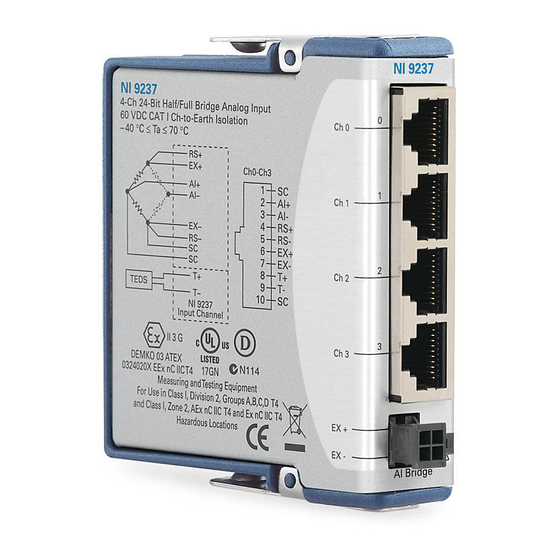Summary of Contents for National Instruments NI 9237
- Page 1 (217) 352-9330 | Click HERE Find the National Instruments NI 9237 at our website:...
- Page 2 GETTING STARTED GUIDE NI 9237 4 AI, ±25 mV/V, 24 Bit, 50 kS/s/ch Simultaneous, Bridge Completion hnology Group - Quality Instrumentation ... Guaranteed | (888) 88-SOURCE | www...
-
Page 3: Safety Guidelines
This document explains how to connect to the NI 9237. In this document, the NI 9237 with RJ-50 and the NI 9237 with DSUB are referred to inclusively as the NI 9237. Before you begin, complete the software and Note hardware installation procedures in your chassis documentation. -
Page 4: Safety Voltages
Continuous 60 VDC, Measurement Category I Withstand 860 Vrms, verified by a 5 s dielectric withstand test NI 9237 Getting Started Guide | © National Instruments | 3 hnology Group - Quality Instrumentation ... Guaranteed | (888) 88-SOURCE | www... -
Page 5: Safety Guidelines For Hazardous Locations
CAT III, or CAT IV. Safety Guidelines for Hazardous Locations The NI 9237 is suitable for use in Class I, Division 2, Groups A, B, C, D, T4 hazardous locations; Class I, Zone 2, AEx nA IIC T4 and Ex nA IIC T4 hazardous locations; and nonhazardous locations only. - Page 6 Caution connected signals must be within the following limits. Capacitance 0.2 μF maximum Inductance 80 mH maximum NI 9237 Getting Started Guide | © National Instruments | 5 hnology Group - Quality Instrumentation ... Guaranteed | (888) 88-SOURCE | www...
- Page 7 Zone 2 hazardous locations, in ambient temperatures of -40 °C ≤ Ta ≤ 70 °C. If you are using the NI 9237 in Gas Group IIC hazardous locations, you must use the device in an NI chassis that has been evaluated as Ex nC IIC T4, Ex IIC T4, Ex nA IIC T4, or Ex nL IIC T4 equipment.
-
Page 8: Electromagnetic Compatibility Guidelines
NI 9237 Getting Started Guide | © National Instruments | 7 hnology Group - Quality Instrumentation ... Guaranteed | (888) 88-SOURCE | www... -
Page 9: Special Conditions For Marine Applications
In addition, take precautions when designing, selecting, and installing measurement probes and cables to ensure that the desired EMC performance is attained. 8 | ni.com | NI 9237 Getting Started Guide hnology Group - Quality Instrumentation ... Guaranteed | (888) 88-SOURCE | www... -
Page 10: Preparing The Environment
Preparing the Environment Ensure that the environment in which you are using the NI 9237 meets the following specifications. Operating temperature -40 °C to 70 °C (IEC 60068-2-1, IEC 60068-2-2) Operating humidity 10% RH to 90% RH, (IEC 60068-2-78) noncondensing... - Page 11 AI3- SC3+ EX– EX– Do not use RJ-45 cables with the NI 9237 Caution with RJ-50. RJ-45 cables damage the RJ-50 connector, 10 | ni.com | NI 9237 Getting Started Guide hnology Group - Quality Instrumentation ... Guaranteed | (888) 88-SOURCE | www...
-
Page 12: Signal Descriptions
Positive sensor excitation connection Negative sensor excitation connection TEDS data connection TEDS return connection Shunt calibration connection NI 9237 Getting Started Guide | © National Instruments | 11 hnology Group - Quality Instrumentation ... Guaranteed | (888) 88-SOURCE | www... - Page 13 NI 9237 with DSUB NI 9237 with RJ50 You also can connect floating signals to the NI 9237. If you connect floating signals to the NI 9237, NI recommends connecting the EX- signal to the earth ground or shield for better noise rejection.
- Page 14 EX- signal to the earth ground or shield for better noise rejection. Bridge Calibration When you insert or remove a new sensor from the NI 9237, slight changes in the excitation voltages can cause a mismatch between the internal half-bridge completion resistors and the half-bridge sensors, which results in a change in the measurement offsets.
- Page 15 RS- /SC- NI 9237 with DSUB NI 9237 with RJ50 You also can use a quarter bridge with the NI 9237 with RJ-50 if you use the NI 9944 or NI 9945 Quarter Bridge Completion Accessory. 14 | ni.com | NI 9237 Getting Started Guide...
- Page 16 NI 9237 Ensure that neither the TEDS data (T+) nor the TEDS return (T-) signal is tied in common to any AI signals on the NI 9237. The NI 9237 connects all the T- signals together internally. The NI 9237 with DSUB has only three T- pins. To connect four TEDS sensors to the NI 9237 with DSUB, wire the TEDS return signals of two of the sensors to one of the T- pins.
-
Page 17: Where To Go Next
LabVIEW Help RELATED INFORMATION C Series Documentation Services & Resources ni.com/services ni.com/info cseriesdoc Located at ni.com/manuals Installs with the software 16 | ni.com | NI 9237 Getting Started Guide hnology Group - Quality Instrumentation ... Guaranteed | (888) 88-SOURCE | www... -
Page 18: Worldwide Support And Services
If your product supports calibration, you can obtain the calibration certificate for your product at ni.com/calibration. NI 9237 Getting Started Guide | © National Instruments | 17 hnology Group - Quality Instrumentation ... Guaranteed | (888) 88-SOURCE | www... - Page 19 U.S. Government Customers: The data contained in this manual was developed at private expense and is subject to the applicable limited rights and restricted data rights as set forth in FAR 52.227-14, DFAR 252.227-7014, and DFAR 252.227-7015. © 2006—2015 National Instruments. All rights reserved. 374186F-01 Oct15...













